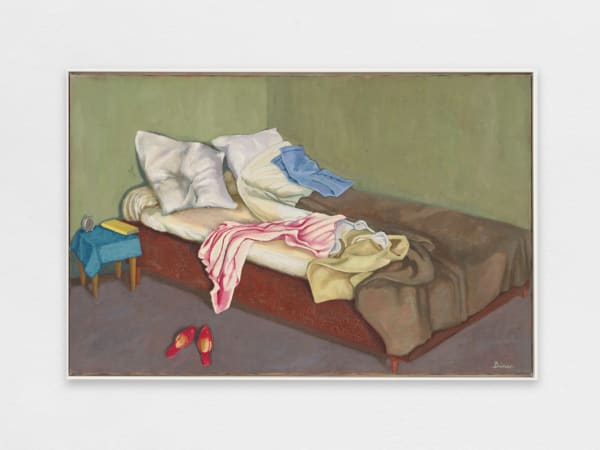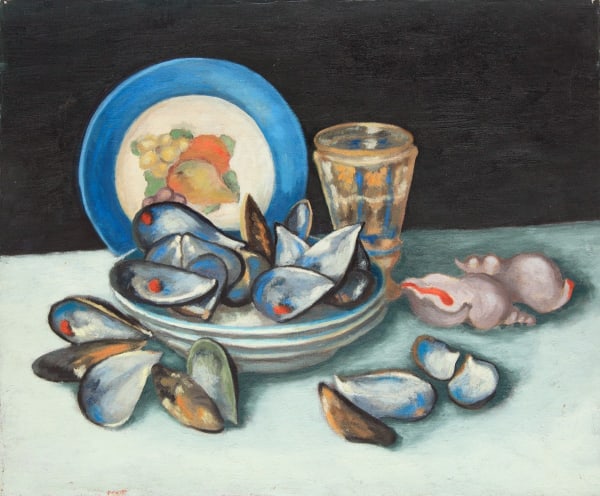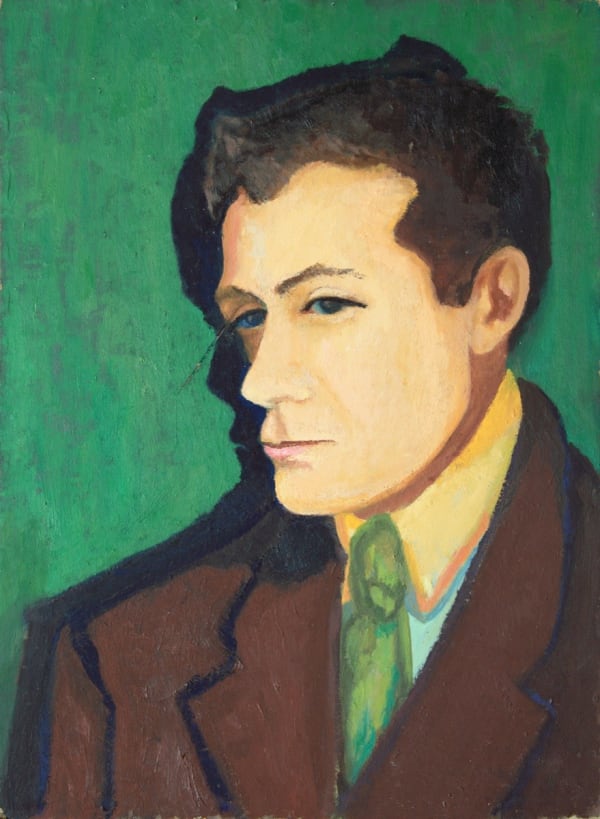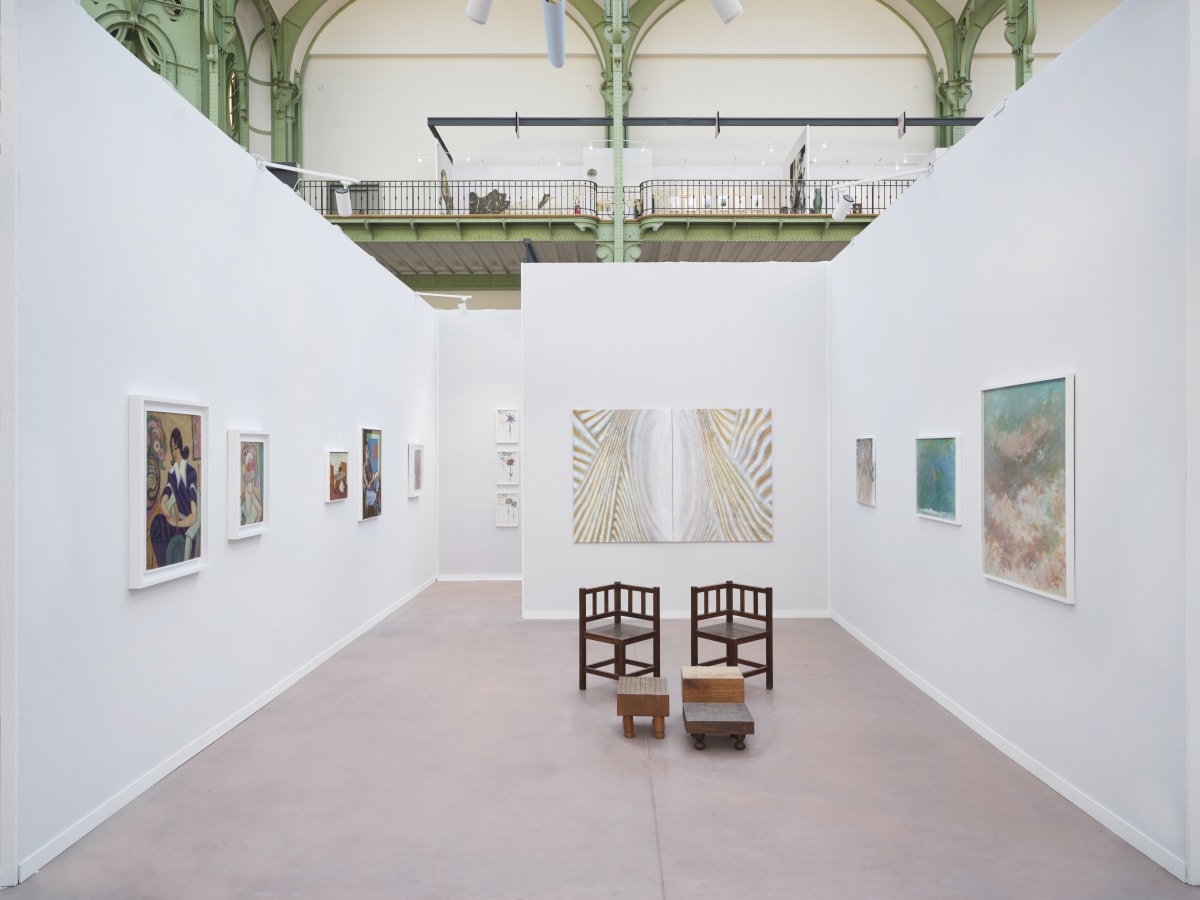« J'ai un terrible désir de peindre, de peindre, de peindre »
Madeleine Dinès, journal non publié, 1926
Madeleine Denis est née le 2 mai 1906 à Saint-Germain-en-Laye, elle est la quatrième fille du peintre nabi Maurice Denis, le « nabi des belles icônes », et la seule des enfants du peintre à suivre une carrière artistique.
Madeleine Denis commence sa formation artistique aux Ateliers d'Art Sacré, fondés par son père, puis étudie avec le philosophe et psychologue Henri Delacroix.
Elle poursuit ses études à la Grande Chaumière et à l'Académie Ranson, et occasionnellement au Bateau-lavoir, où son beau-frère, le sculpteur suisse Marcel Poncet, possède un atelier dans lequel elle vient parfois travailler. En 1929, elle participe au Salon des Tuileries.
Elle s'affirme comme jeune artiste en réaction à l'œuvre de son père et signe ses premières toiles au milieu des années vingt, changeant son nom en « Madeleine Dinès », puis, plus radicalement, en « Dinès » à partir de 1932. Dès le moment où elle signe sans prénom, Dinès affiche clairement sa volonté d'être considérée comme une artiste, quel que soit son sexe.
Pendant ses études, Dinès se lie d'amitié avec la peintre d'origine espagnole Maria Blanchard, dont elle fréquente l'atelier, se rapproche de Chana Orloff et rencontre le poète Jean Follain, qu'elle épouse en 1934.
Le couple mène une vie de bohème, chacun de son côté, Madeleine et Jean ayant besoin de paix et de liberté pour créer. Follain présente Dinès à ses amis poètes et écrivains, avec lesquels elle noue des liens étroits (Apollinaire, Max Jacob, André Salmon, Jean Paulhan, etc.).
Dans sa peinture, Dinès poursuit une voie réaliste, aux antipodes des scènes sacrées de son père Maurice Denis, mais aussi de la voie abstraite et surréaliste typique de son époque :
Natures mortes, bouquets, paysages champêtres, intérieurs familiers, autoportraits, saynètes, nus... Les nombreux portraits qu'elle réalise (Armen Lubin, Maria Blanchard, René de Obaldia, Alain Cuny etc.) sont ceux d'amis proches et de personnalités du monde des arts et de la littérature, mais aussi d'anonymes rencontrés lors de ses voyages en France et à l'étranger.Dans les années 1960, ses couleurs puissantes et sa structure solide rapprochent certains de ses tableaux du mouvement « pop ».
Son style délibérément traditionnel évite la banalité et rend la vie secrète de chaque objet et de l'intime. Elle réhabilite le quotidien au détriment de l'imagination pure.
En 1937, Dinès participe au Salon des femmes artistes modernes, fondé et présidé par Marie-Anne Camax Zoegger. La même année, elle organise sa première exposition personnelle à la galerie parisienne La Fenêtre ouverte. Par la suite, elle alterne les expositions personnelles et collectives en France et à l'étranger. En 1943, Dinès organise sa deuxième exposition personnelle à la galerie du Dragon à Paris, sur une invitation de Léon-Paul Fargue.
Après la mort accidentelle de Jean Follain en 1971, Madeleine Dinès abandonne la peinture pour se consacrer principalement à la promotion de l'œuvre de son mari. Elle s'éteint en 1996, dans son appartement de la place des Vosges.
Féministe de la première heure, elle fut une femme indépendante et moderne, en retrait du monde de l'art et des grands courants du XXe siècle, mais sa peinture figurative fait aujourd'hui écho aux bouleversements artistiques contemporains.
« I have a terrible desire to paint, to paint, to paint »
Madeleine Dinès, unpublished diary, 1926
Madeleine Denis was born on May 2, 1906 in Saint-Germain-en-Laye, she is the fourth daughter of Nabi painter Maurice Denis, the “Nabi of beautiful icons”, and the only one of the painter’s children to follow an artistic career.
She began her artistic training at the Ateliers d’Art Sacré, founded by her father, and later studied with philosopher and psychologist Henri Delacroix. Madeleine Denis continued her studies at the Grande Chaumière and the Académie Ranson, and occasionally at the Bateau-lavoir, where her brother-in-law, Swiss sculptor Marcel Poncet, had a studio in which she sometimes came to work. In 1929 she took part of the Salon des Tuileries.
She established herself as a young artist in reaction to her father’s work, and signed her first canvases in the mid-twenties, changing her name to “Madeleine Dinès”, and even, more radically, to “Dinès” from 1932 onwards. From the moment she signed without a first name, Dinès clearly demonstrated her desire to be considered an artist, regardless of her gender.
During her studies, Dinès befriended the Spanish-born painter Maria Blanchard, whose studio she frequented, became close to Chana Orloff and met the poet Jean Follain, whom she married in 1934.
The couple led a bohemian life, each on their own, Madeleine and Jean needing peace and freedom to create. Follain introduced Dinès to his poet and writer friends, with whom she forged close ties (Apollinaire, Max Jacob, André Salmon, Jean Paulhan etc.).
In her painting, Dinès pursued a realist path, the antithesis of the sacred scenes of her father Maurice Denis, but also of the abstract and surrealist path typical of her era: Still lifes, bouquets, country landscapes, familiar interiors, self-portraits, playlets, nudes... The many portraits she painted (Armen Lubin, Maria Blanchard, René de Obaldia, Alain Cuny etc.) were of close friends and personalities from the world of art and literature, but also of anonymous people she met on her travels in France and abroad. In the 1960s, her powerful colors and solid structure brought some of her paintings closer to the “pop” movement.
Her deliberately traditional style avoids banality, rendering the secret life of each object and the intimate. She rehabilitates the everyday to the detriment of pure imagination.
In 1937, Dinès took part in the Salon des Femmes Artistes Modernes, founded and chaired by Marie-Anne Camax Zoegger. That same year she organized her first solo show at the Parisian gallery La Fenêtre ouverte, and she subsequently alternated between solo and group shows in France and abroad. In 1943, Dinès organized her second solo show, at the Galerie du Dragon in Paris, with an invitation written by Leon-Paul Fargue.
After Jean Follain’s accidental death in 1971, Madeleine Dinès gave up painting for devoting herself mainly to promoting her husband’s work. She passed away in 1996, in her apartment on the Place des Vosges.
A feminist from the outset, she was an independent, modern woman who took a back seat to the art world and the major currents of the 20th century, but her figurative painting today echoes contemporary artistic upheavals.
Collections Publiques
Musée Maurice Denis, Saint-Germain-en-Laye, FR
IMEC, Caen, FR
Musée des Années Trente, Boulogne-Billancourt, FR
Musée Delacroix, Paris, FR
Musée de Cabriès, FR
Musée Bonnard, Cannet, FR
Musée d’Art et d’Histoire de Saint-Lô, FR








